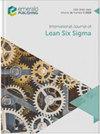基于模糊DEMATEL方法的精益壁垒可持续解决方案——以印度制造业为例
IF 3.7
2区 工程技术
Q2 ENGINEERING, INDUSTRIAL
引用次数: 2
摘要
目的新冠肺炎疫情在第四次工业革命时代肆虐全球,制造业面临百年来最糟糕的形势。被誉为“战士哲学”的精益哲学可以成为这些行业的救星。本研究旨在确定精益战略实施的障碍,并进行分析,为政策制定者、从业者和决策者提供认识。设计/方法/方法本研究旨在将阻碍精益战略执行的障碍分为七个主要障碍/组成部分,其中使用模糊DEMATEL方法来评估关键因素以及其中的因果因素。征求专家意见以获取相关数据,用于评估目的。研究结果表明,企业应关注企业文化冲突情景、资源反应能力、改善供应商态度以及执行适当的规划和物流等式,以缓解实施精益的障碍。由于这些因果因素影响着影响因素,即高层管理者的愿景、管理层与员工的关系和人力资源建设,关注它们会自动改善影响因素;因此,克服对精益实施的阻力的激增得到了缓解。实际意义这项研究有助于识别和分析制造业和工业部门的精益实施问题。得出的观察结果、结果和见解可以作为打破精益实施领域阻力的指导力量,并可能恢复行业在后新冠肺炎时代的生存和卓越表现。独创性/价值这项研究以一种独特的方式引入了精益实施的障碍,因为它阐明了行业的所有部门,并根据分类对障碍进行了分组。它进一步优先考虑了障碍在印度工业场景中的重要性。这将有助于行业专业人士和管理人员克服障碍,并深入了解如何以及在哪里开始实施精益。本文章由计算机程序翻译,如有差异,请以英文原文为准。
A sustainable solution for lean barriers through a fuzzy DEMATEL methodology with a case study from the Indian manufacturing industry
Purpose
As the COVID-19 epidemic ravages the world in the fourth industrial revolution era, the manufacturing sector faces its worst situation in a century. Lean philosophy, renowned as a “warrior philosophy,” can be an able rescuer to these industries. This study aims to identify the hurdles to lean strategy implementation and conduct an analysis to provide cognizance to policymakers, practitioners and decision-makers.
Design/methodology/approach
This study aims to identify the obstacles that obstruct lean implementation into seven primary barriers/components, with the fuzzy DEMATEL approach being used to evaluate the critical factors as well as the cause and effect factors among them. Expert opinions are sought to obtain the relevant data for evaluation purposes.
Findings
The results reveal that a firm should focus on firm cultural conflict scenario, resources–responses incapability, improve on suppliers’ attitude and execute a proper planning and logistics equation to alleviate the hindrances of implementing lean. As these causal factors influence the effect factors, namely, top management vision, management–employee relationship and human resource building, focusing on them automatically improves the effect factors; thus, the surge to overcome resistance to lean implementation is alleviated.
Practical implications
This research aids in identifying and analyzing lean implementation issues in the manufacturing and industrial sectors. The observations, results and insights drawn can act as a guiding force to rupture the resistance envelope covering the domain of lean implementation and possibly reinstating industries to survive and excel in the business post-COVID era.
Originality/value
This research introduces barriers to lean implementation in a unique way, as it articulates all sections of an industry and group the barriers based on the classification. It further prioritizes the barriers for their importance in the Indian industrial scenario. This would help the industry professionals and managers access the barriers and generate insight on how and where to start implementing lean.
求助全文
通过发布文献求助,成功后即可免费获取论文全文。
去求助
来源期刊

International Journal of Lean Six Sigma
Engineering-Industrial and Manufacturing Engineering
CiteScore
8.90
自引率
15.00%
发文量
46
期刊介绍:
Launched in 2010, International Journal of Lean Six Sigma publishes original, empirical and review papers, case studies and theoretical frameworks or models related to Lean and Six Sigma methodologies. High quality submissions are sought from academics, researchers, practitioners and leading management consultants from around the world. Research, case studies and examples can be cited from manufacturing, service and public sectors. This includes manufacturing, health, financial services, local government, education, professional services, IT Services, transport, etc.
 求助内容:
求助内容: 应助结果提醒方式:
应助结果提醒方式:


